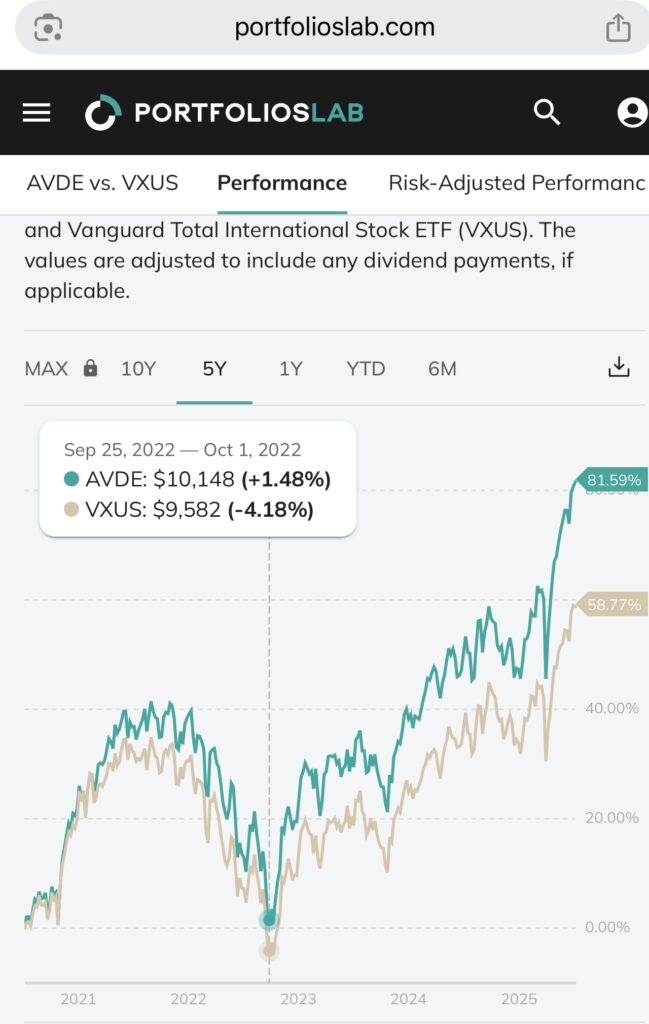I didn’t set out to own AVDE.
When markets plunged in 2022, I faced something I hadn’t in decades of investing since 1997: a significant loss in my long-held Vanguard international mutual fund. After years of adding to it, seeing it in the red felt humiliating. But that pain also created an opportunity. With losses finally large enough to matter, I decided it was time to put my tax-loss harvesting knowledge to work.
Looking back, my tax-loss harvesting timing wasn’t about calling the bottom or having any certainty about what the market would do next. I honestly didn’t know if losses would deepen. The real reason I acted was simple: after years of steady investing, the loss had finally become meaningful enough to matter for taxes. That was my signal—not any special insight or prediction.
I never doubted that I should stay invested. For me, harvesting the loss was just a tactical move; the real strategy was always to keep my money working in the market. I’ve learned that it’s less about timing things perfectly and more about responding thoughtfully to what’s actually happening in my own portfolio. When the loss was big enough to matter, I acted. But through it all, my long-term commitment to staying invested never wavered. That’s what really made the difference.
I sold my old Vanguard fund — not the ETF VXUS, but the mutual fund version — to lock in the loss and offset gains elsewhere. I still wanted international exposure and needed to avoid the wash sale rule, so I looked for a similar fund. That’s how I landed on AVDE — the Avantis International Equity ETF. I noticed it had a slightly higher expense ratio and a tilt toward small-cap and value stocks, but I needed to stay invested, and it seemed like a reasonable alternative.
After the market started recovering from October 2022, I noticed AVDE was bouncing back a bit faster. When my wash sale window was over, I decided not to switch back. I simply held on.
How Did It Turn Out?
Fast forward to today: that half-accidental, half-strategic move worked out surprisingly well.
AVDE gained about 77% since then, compared to roughly 62% for my old international fund. On a $10,000 investment, that’s the difference between ending up with $17,700 versus $16,200. Not earth-shattering, but a meaningful edge — all from a decision I made in a moment of loss and humility.
What I Learned (and What I Missed the First Time)
- Even seasoned investors face setbacks. After decades of steady investing, seeing a loss was tough to swallow. But losses — while humbling — can be a springboard for smart, proactive moves.
- Tax-loss harvesting is a powerful tool — when used wisely. Waiting for a meaningful loss made the effort worthwhile. Understanding the mechanics, like avoiding the wash sale rule by picking a similar but not identical fund, helped me stay invested and tax-efficient.
- Staying invested beats trying to time the market. I didn’t try to predict the bottom. I just made sure my money stayed working for me, which did most of the heavy lifting.
- Factor tilts (like small-cap or value) can help — or hurt. AVDE’s tilt gave it a modest edge this time, but there’s no guarantee it will always outperform. Factor-based funds can lag for long periods, so I want to be clear about what I own.
- Costs matter, especially over time. AVDE’s higher expense ratio didn’t erase its outperformance in this window, but over decades, even small fee differences can add up.
- Emotional resilience is part of investing. Feeling embarrassed or frustrated by losses is normal — even after years of experience. What matters is how I respond.
- Nobody knows the future. This move worked out, but markets are unpredictable. I try to stay humble, flexible, and always keep learning.
- Timing, size of my contributions — and dividends — all mattered. Because most of my contributions were made after 2010, the steep decline in 2022 made it entirely plausible for me to face a loss — even after decades of investing. But there’s another layer: all those dividends that were automatically reinvested over the years got added to my cost basis, making the loss seem larger on paper than it might have been in economic reality. I may not have had a “true” loss if I looked only at my original contributions versus what I could take out. It drove home how both when and how much I invest — plus how dividends play into cost basis — all shape the risk and reward of long-term investing.
A Quick Comparison
| Fund | Description | Expense Ratio (2025) | Factor Tilt | Typical Benchmark |
|---|---|---|---|---|
| AVDE | Avantis International Equity ETF | 0.23% | Small-cap, value | MSCI ACWI ex USA IMI |
| Vanguard Intl Fund | Vanguard Total International Stock Index Fund | 0.11% | Broad market | FTSE Global All Cap ex US |
- AVDE aims to capture extra returns by tilting toward smaller and value-oriented international stocks, which can increase volatility and tracking error relative to a broad index.
- Vanguard’s fund is a plain-vanilla, market-cap-weighted international fund, with lower costs and less factor exposure.
A Crucial Lesson: The Cost of Quitting at the Bottom
If I had sold everything and stayed in cash after October 2022, the said investment would have remained at hypothetical $10,000 — missing out on the recovery entirely. By staying invested in AVDE, that same $10,000 grew to $17,700. The difference isn’t just numbers on a page: it’s a real, tangible reward for holding steady when it felt hardest.
This experience reinforced for me that resisting the urge to quit during downturns can make all the difference in long-term investing outcomes.
Final Thoughts
My accidental switch to AVDE was born out of a tough moment, but it reinforced some of the most important lessons in investing: act when opportunity strikes, stay invested, and don’t let setbacks define me. Even experienced investors have been there — and sometimes, a well-timed, thoughtful move can turn a setback into an advantage.
(Not investment advice — just sharing one investor’s journey, with all its ups, downs, and lessons learned.)

